

You are using an out of date browser. It may not display this or other websites correctly.
You should upgrade or use an alternative browser.
You should upgrade or use an alternative browser.
Joey Rott
New Member
I read this on another forum I frequently visit, and thought it was pretty incredible, as it was just 2 years after planting. If you look close enough you can see the little acorns. It's a standard white oak that came from the forestry service in Ontario.

I couldn't believe it.The area I had planted in 2006 one of the white acorns produced a few nuts this year.

dbltree
Super Moderator
I read this on another forum I frequently visit, and thought it was pretty incredible, as it was just 2 years after planting. If you look close enough you can see the little acorns. It's a standard white oak that came from the forestry service in Ontario.

Those are the kind of trees we want to select acorns from....:way:
Joey Rott
New Member
Last but not least my favorites!!! American Chestnuts from the ID State Nursery.

What are your thoughts on the possibility of blight with the American Chestnuts? I'd like to get some pure American strains if I knew there was a good probability of them doing fine. I saw on the ID nursery site that they could be "grown in the west blight-free"... so I would assume it depends some on location.
Joey Rott
New Member
I snapped a few pictures last night. One thing I noticed on nearly 80% of my trees, is that I had some die-back on the limbs. Last summer I had a problem with grasshoppers eating 25-75% of the leaves and some of the bark off the trees, which may have had something to do with it.

This Sycamore is a great example. It was going great last year and 2-3ft tall, but this year it's all dead except the bottom inch. Most of the Sawtooth are the same way. There is good growth in the bottom couple inches, but it'll take them another year to get the height back.
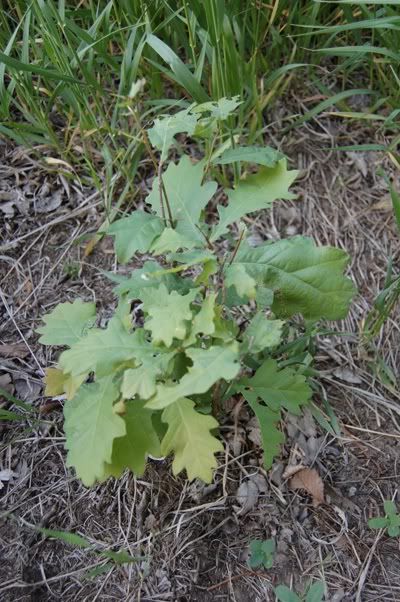
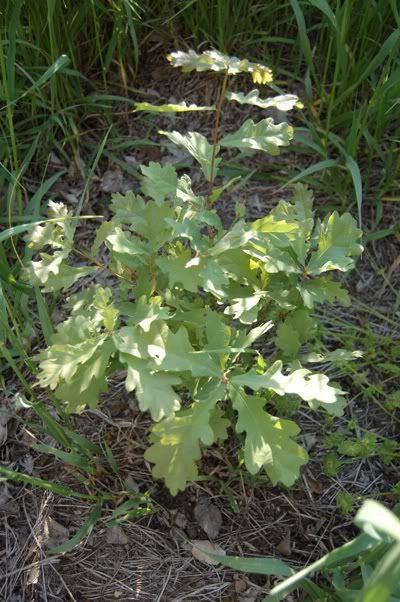
The English and Sawtooth Oaks were probably the most successful types from last year. I had success rates of around 75%. Some of the English Oaks are really shooting out.
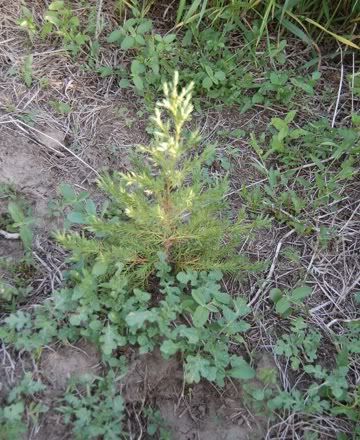
Last year I planted 250 Norway Spruce Trees... which ended up being a bad idea. Only 4-5 still alive, so virtually a complete loss. Between the lack of enough water and 100+ heat, it was too much for them. So this year I replaced them with 2 yr transplants from Coldstream. So far they're doing good, and I'm betting I'll have a much better success rate.
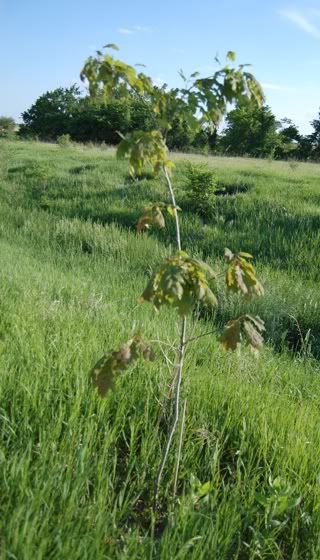
I also planted 100 Red Oak Seedlings last year, which also was a bad idea. There are only 5-10 left. I was able to pick up a few large potted Red Oaks last summer for under a $1 each locally, on a closeout sale. Those are all still alive, and doing well this Spring.
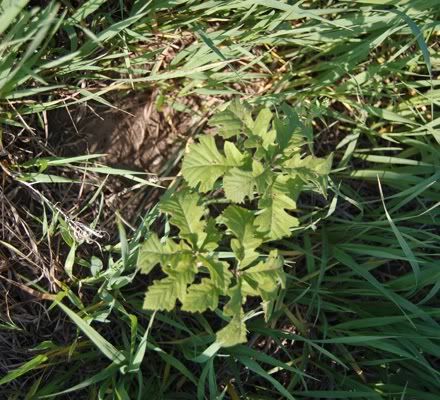
Last Oct-Nov, I transplanted a handful of Bur Oaks from the nearby river, and they all made it and are doing great.
Probably the biggest thing I've learned is to stick with the hardiest drought/heat tolerant trees from now on. And I will try to look into getting plugs more than bareroot, if available. Last year was even a wetter summer than normal, but it seemed some types still didn't get enough, even with my weekly/bi-weekly bucket watering.
I received a few free Blue Spruce Plugs from the local hardware store that I also planted with the rest of the bareroot Norway seedlings. Most of the Plugs actually made it.

This Sycamore is a great example. It was going great last year and 2-3ft tall, but this year it's all dead except the bottom inch. Most of the Sawtooth are the same way. There is good growth in the bottom couple inches, but it'll take them another year to get the height back.


The English and Sawtooth Oaks were probably the most successful types from last year. I had success rates of around 75%. Some of the English Oaks are really shooting out.

Last year I planted 250 Norway Spruce Trees... which ended up being a bad idea. Only 4-5 still alive, so virtually a complete loss. Between the lack of enough water and 100+ heat, it was too much for them. So this year I replaced them with 2 yr transplants from Coldstream. So far they're doing good, and I'm betting I'll have a much better success rate.

I also planted 100 Red Oak Seedlings last year, which also was a bad idea. There are only 5-10 left. I was able to pick up a few large potted Red Oaks last summer for under a $1 each locally, on a closeout sale. Those are all still alive, and doing well this Spring.

Last Oct-Nov, I transplanted a handful of Bur Oaks from the nearby river, and they all made it and are doing great.
Probably the biggest thing I've learned is to stick with the hardiest drought/heat tolerant trees from now on. And I will try to look into getting plugs more than bareroot, if available. Last year was even a wetter summer than normal, but it seemed some types still didn't get enough, even with my weekly/bi-weekly bucket watering.
I received a few free Blue Spruce Plugs from the local hardware store that I also planted with the rest of the bareroot Norway seedlings. Most of the Plugs actually made it.
Last edited:
dbltree
Super Moderator
You might just need to do a little more research on trees that are both winter hardy and drought resistant in your area Joey. I'm just wondering if some of the die back was from winter weather?
Drought is a huge problem for ALL new seedlings and I suspect your area is a little drier then ours here in Iowa.
New seedlings don't have the root system to withstand going without water like established trees but some species are adapted to that.
Like White Swamp Oak is asdapted to wet areas other oaks prefer dry soils and Okios tree crops carries some of those oak species such as :
Hybur Oak — Quercus macrocarpa x virginiana,gambelli,alba
Keep us posted on progress this summer...
Drought is a huge problem for ALL new seedlings and I suspect your area is a little drier then ours here in Iowa.
New seedlings don't have the root system to withstand going without water like established trees but some species are adapted to that.
Like White Swamp Oak is asdapted to wet areas other oaks prefer dry soils and Okios tree crops carries some of those oak species such as :
Hybur Oak — Quercus macrocarpa x virginiana,gambelli,alba
Keep us posted on progress this summer...
Joey Rott
New Member
You're right, choosing the right oaks will be key. The Bur Oak is the only native oaks in the area. Staying with them and certain Bur hybrids should be good. As soon as the ID state nursery starts accepting new orders for next spring, I'll be putting mine in right away.
I think between the winter & late summer grasshopper damage, it was too much for many of the seedlings. The hoppers became thick for the last month of summer. I even sprayed them with some liquid insecticide containing permethrin, but it had little effect. I'm going to try some more potent stuff like Seven this year. 1 healthy Red Delicious Apple and 2 Hardy Apricot trees, were also lost... once they started to eat the top layer of bark, they were dead pretty quick.
They didn't bother the Cherry, Pear or other natives like Hackberry, Cottonwood, etc trees one bit though.
I'm just wondering if some of the die back was from winter weather?
I think between the winter & late summer grasshopper damage, it was too much for many of the seedlings. The hoppers became thick for the last month of summer. I even sprayed them with some liquid insecticide containing permethrin, but it had little effect. I'm going to try some more potent stuff like Seven this year. 1 healthy Red Delicious Apple and 2 Hardy Apricot trees, were also lost... once they started to eat the top layer of bark, they were dead pretty quick.
They didn't bother the Cherry, Pear or other natives like Hackberry, Cottonwood, etc trees one bit though.
letemgrow
PMA Member
Joey, you should do pretty well with American Chestnuts. The Morton Estate in Nebraska City had giant American Chestnuts that were the size of a giant cottonwood to give you an example of their dimensions. The only thing that took those chestnuts out was a water line they ran through them!!! Not sure what they were thinking on that one.
Here is a pic of one of the stumps. I was so excited to finally see a giant american chestnut, only to find out, it had been cut down a few years before cause of the water line.

It had already started up another sprout even though it had to be an ancient tree!!

Here is a pic of one of the stumps. I was so excited to finally see a giant american chestnut, only to find out, it had been cut down a few years before cause of the water line.

It had already started up another sprout even though it had to be an ancient tree!!

letemgrow
PMA Member
My seedlings and seeds seem to be doing pretty well.
2 year old Northern Red from the MDC Nursery. They were listed as x-large 1 year old trees. I order every single oak that they offer as XL in a given year. They are the trees that the best of the 1-year old seedlings and have to have a minimum hieght of usually 30-36 depending on the particular species. One of the northern reds was over 4 foot tall when it arrived as a 1-year old tree!!

Hybrid oak acorns planted last fall.

American Chestnut from the seed.

2 year old Northern Red from the MDC Nursery. They were listed as x-large 1 year old trees. I order every single oak that they offer as XL in a given year. They are the trees that the best of the 1-year old seedlings and have to have a minimum hieght of usually 30-36 depending on the particular species. One of the northern reds was over 4 foot tall when it arrived as a 1-year old tree!!

Hybrid oak acorns planted last fall.

American Chestnut from the seed.

turkeyriver
PMA Member
For drier climates you might want to try Black Hills Spruce instead of Norway. They are a little slower growing but better adapted to arid conditions.
Joey Rott
New Member
Joey, you should do pretty well with American Chestnuts. The Morton Estate in Nebraska City had giant American Chestnuts that were the size of a giant cottonwood to give you an example of their dimensions. The only thing that took those chestnuts out was a water line they ran through them!!! Not sure what they were thinking on that one.
Here is a pic of one of the stumps. I was so excited to finally see a giant american chestnut, only to find out, it had been cut down a few years before cause of the water line.

It had already started up another sprout even though it had to be an ancient tree!!

Dang... Too bad to see a Great Tree like that be taken out because of something like a waterline. You're right, I'm not sure what they were thinking.
For drier climates you might want to try Black Hills Spruce instead of Norway. They are a little slower growing but better adapted to arid conditions.
Thanks, good recommendation. Not sure why I didn't of that those. I bet they would have a good chance around here.
dbltree
Super Moderator
Normally I reccomend using Oust and roundup the fall before a tree planting and then follow up herbicide control after planting. I didn't get cost share approval until too late and then I had some unusal circumstances that had me unsure exactly where rows would be this spring.
One area my son and I cleared of thorn trees and blackberry brambles this spring before planting and the area was wet and uneven. When we planted, I just headed the tractor and planter wherever I could get between stumps, girdled trees and wet areas.
Long story short, I'm spraying after trees budded out which requires a little care not to spray the tree leaves themselves. Surflan is safe over the top but Oust can damage or even kill new seedlings when sprayed over the top of trees that have leafed out.
Oak seedlings can tolerate Oust but most shrubs cannot, conifers can handle atrazine and even roundup if they have not started growing (mine have )
)
At any rate I have mutiple situations requiring different (or allowing) herbicide combinations.
I've been band spraying everything with my 3 gallon backpack sprayer and spraying an atrazine/roundup combo around (not over top) all the red cedar seedlings.
Surflan is a pre-emergent herbcide but Oust is both pre-and post:
I used Surflan and select 2-EC on some newly planted oaks but in the area we cleared and the oaks have had plenty of rain to settle soil around the roots I used Surflan and Oust XP at 1 quart and oneounce in 3 gallons of water.
I tried to avoid any contact with the leaves but of course managed to hit a 1/2 dozen out of perhaps a thousand seedlings, so we'll see if they survive or not.
I used no surfactant:
Obviously Oust is pretty potent stuff which is also why it works so well.
My hope is that it will nuke the blackberries and goldenrod coming up in that planting and then provide residual control.
Oust XP Label
Oust is in a granular form that requires careful measuring with a this hand deal that is a little like measuring black powder...

I measured one ounce, twist it shut and remove the measuing canister from the bottle.

The Surflan has a yellow dye in it which really helped to know where I sprayed...
Before....

After...

Notice there is no grass in this situation, so I didn't add Select (clethodim)
One area my son and I cleared of thorn trees and blackberry brambles this spring before planting and the area was wet and uneven. When we planted, I just headed the tractor and planter wherever I could get between stumps, girdled trees and wet areas.
Long story short, I'm spraying after trees budded out which requires a little care not to spray the tree leaves themselves. Surflan is safe over the top but Oust can damage or even kill new seedlings when sprayed over the top of trees that have leafed out.
Oak seedlings can tolerate Oust but most shrubs cannot, conifers can handle atrazine and even roundup if they have not started growing (mine have
At any rate I have mutiple situations requiring different (or allowing) herbicide combinations.
I've been band spraying everything with my 3 gallon backpack sprayer and spraying an atrazine/roundup combo around (not over top) all the red cedar seedlings.
Surflan is a pre-emergent herbcide but Oust is both pre-and post:
DuPont™ Oust<SUP>® is a soil residual herbicide with some knockdown action. It controls susceptible weeds through both post-emergence and pre-emergence (residual) action. DuPont™ Oust® may be applied pre-emergence or post-emergence to the weeds; best results are obtained if application is made before or during the early stages of weed growth. </SUP>
<SUP>
Adequate soil moisture is required for DuPont™ Oust® to be activated so it can provide optimum weed control. Under limited rainfall conditions, DuPont™ Oust® may not provide satisfactory control of hard-to-kill annuals and perennial weeds.
The higher use rates give longer term residual control. The degree of control and duration of effect will vary with the rate of application, soil texture, organic matter content, soil pH, rainfall and other environmental conditions.
When applied as a spray, OUST® XP is absorbed by both
the roots and foliage of plants, rapidly inhibiting the growth
of susceptible weeds.
</SUP>
I used Surflan and select 2-EC on some newly planted oaks but in the area we cleared and the oaks have had plenty of rain to settle soil around the roots I used Surflan and Oust XP at 1 quart and oneounce in 3 gallons of water.
I tried to avoid any contact with the leaves but of course managed to hit a 1/2 dozen out of perhaps a thousand seedlings, so we'll see if they survive or not.
I used no surfactant:
If a surfactant is used with OUST® XP, allowing the spray
to contact tree foliage may injure or kill trees. The user
assumes all responsibility for tree injury if a surfactant is
used with OUST® XP treatments applied after planting.
Obviously Oust is pretty potent stuff which is also why it works so well.
My hope is that it will nuke the blackberries and goldenrod coming up in that planting and then provide residual control.
Oust XP Label
Oust is in a granular form that requires careful measuring with a this hand deal that is a little like measuring black powder...

I measured one ounce, twist it shut and remove the measuing canister from the bottle.

The Surflan has a yellow dye in it which really helped to know where I sprayed...
Before....

After...

Notice there is no grass in this situation, so I didn't add Select (clethodim)
dbltree
Super Moderator
So far, it looks like perhaps 5% or less mortality of anyoak seedlings from any source but the red cedar mortaility is very high somewhere betwen 30-40% and that may go up!
Some oaks are still waking up...

by and large they are all doing very well including the hybrid oaks from Idaho

and Dwarf Chinkapin Oaks from Okios Tree Crops

This is a 2008 tree planting one year later which shows why follow up herbicide and mowing is needed in new tree plantings...

As soon as all the new seedlings are sprayed, we'll start on last years...
Some oaks are still waking up...

by and large they are all doing very well including the hybrid oaks from Idaho

and Dwarf Chinkapin Oaks from Okios Tree Crops

This is a 2008 tree planting one year later which shows why follow up herbicide and mowing is needed in new tree plantings...

As soon as all the new seedlings are sprayed, we'll start on last years...
dbltree
Super Moderator
Great work Paul!!! Some type of marker is what I need to add when I spray roundup so I can see exactly where I have hit.
I'm sure you can find dye locally but here's a source and idea of what to ask for
INDICATOR DYE
dbltree
Super Moderator
[FONT=Georgia,Times New Roman,Times,serif]Okios Tree Crops has monthly sales and has Chestnutleaf Oaks on sale if anyone is interested. I enjoy planting different species and this one does well on sandy droughty soils if you happen to have those kind of soil conditions.[/FONT]
[FONT=Georgia,Times New Roman,Times,serif]Chestnutleaf Oak[/FONT] Quercus castanaefolia 30% off
One of the best species oak trees we grow for fast growth averaging 2-3 ft. per year. Clean foliage, highly vigorous on almost all soil types except water logged soils. Preferred over sawtooth oak for acorn production.
each 3 or more 25 or more each 3 or more 25 or more
 Chestnutleaf Oak Acorns
Chestnutleaf Oak Acorns
[FONT=Georgia,Times New Roman,Times,serif]Chestnutleaf Oak[/FONT] Quercus castanaefolia 30% off
One of the best species oak trees we grow for fast growth averaging 2-3 ft. per year. Clean foliage, highly vigorous on almost all soil types except water logged soils. Preferred over sawtooth oak for acorn production.
each 3 or more 25 or more each 3 or more 25 or more
6-12" Sale Price: $5.60 $5.25 $2.24 1-2' Sale Price: $7.00 $6.65 $2.94
6-12" List Price: $8.00 $7.50 $3.20 1-2' List Price: $10.00 $9.50 $4.20
6-12" List Price: $8.00 $7.50 $3.20 1-2' List Price: $10.00 $9.50 $4.20

